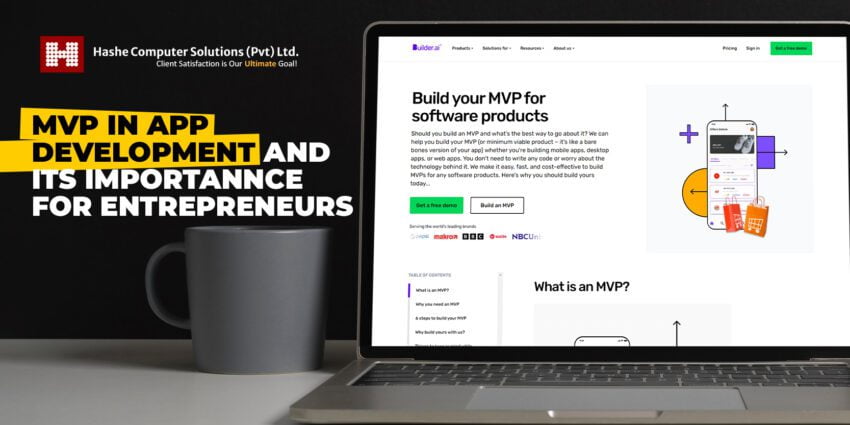
While designing a custom mobile app, many entrepreneurs make the error of attempting to create a fully functional product from the start. However, this technique might be risky and expensive in the long run. Rather than beginning from scratch, think about creating a Minimum Viable Product (MVP) that only has the essential features required for the program to work.
Entrepreneurs who do this can put their product to the test in the market, get input from early users, and adjust as needed before devoting additional time and money to development. In this article, we’ll discuss the advantages of MVPs in app development and how they may assist business owners save time and money while releasing a popular mobile app.
What is MVP in App Development?
The MVP is the initial version of an app that may be released to the public and still be considered an app, specifically in terms of producing a successful app. An app MVP kicks off a mutual learning process in which developers discover how users engage with it. At the same time, users become accustomed to the app and its fundamental functionality.
Developers must consider creating apps in the same way that programmers do when writing code. An example of an MVP for a writing tool is a free spell checker. Users who become accustomed to using the spell checker validate the app’s usefulness, and it becomes natural. Utilizing the data collected from the MVP, app developers can release more features and charge a price for using them.
Minimum Loveable and Minimum Marketable
An MVP can serve as a research data source for the app’s further iteration and a marketing tool. The minimum marketable product, or MMP, has inherent marketing that contributes to the model’s rise in popularity. An MMP is comparable to a test drive-only basic model automobile. The vehicle only operates as a vehicle; it cannot perform any other functions.
On the other hand, A minimum loveable product provides consumers with value by giving them something they are willing to pay for in the future. Users must overcome the barrier where consumers tolerate features but utilize them because they are free, only to abandon them when they become expensive. The MLP business model aims to have customers who “can’t live without” the product and are eagerly anticipating its next iteration.
Key Characteristics of an MVP
All MVPs have the following three characteristics.
- It needs to generate enough initial interest to enable the creation of an MVP. DropBox had clients before it even had a product because of the amount of interest it created with its first product introduction video. It occurred years before online storage and cloud computing became commonplace.
- The MVP must pique enough interest to remain viable. The objective is to hold users’ attention over one second and, ideally, longer. People should be eager to see the product’s next iteration, even if it is only the bare minimum.
- Lastly, MVPs are learning settings where producers and customers can get to know one another. Therefore, feedback loops are essential to a product’s transition from one version to the next. Since the feedback loop is a form of market research, adequate resourcing is necessary to ensure that it generates results.
Pros and Cons of Using An MVP
The usefulness of MVP development as a company startup planner is one of its best features. The rationale behind employing an MVP applies to small-scale business thinking that may culminate in large-scale thinking. On the other hand, any system, including a content management system, can be designed and implemented using an MVP. Some project management processes make use of readily scalable MVPs.
Pros
- Occasionally, a startup tries to overachieve by introducing too many features in the first release of their product. Since there isn’t any space for anything more, starting with a basic MVP prevents feature creep. The features can be planned for later, but not at the expense of the first MVP.
- MVPs prioritize marketing and foster an atmosphere that increases user value even without the MMP focus. While obtaining marketing data for upcoming iterations, one can continue concentrating marketing on promoting the initial MVP version.
- MVPs are a quick and inexpensive way for a startup to get an initial business operational and running. Customers do not need to visualize a product before utilizing it. This indicates the startup already knows a target audience for its MVP. In some cases, quickly developing a business is essential to maintaining competitiveness in a swiftly evolving market.
Cons
- The most significant downside is a lack of flexibility after the MVP’s deployment. A startup should ideally have momentum as the MVP becomes more well-known. If the startup leverages the early interest as a starting point for data collection, then a lack of flexibility isn’t all that awful. The following update addresses any flexibility issues in the previous version.
- The MVP’s technology stack may not be able to support future growth, which is another drawback. Although it doesn’t have to be, this mistake can be fatal. A tech startup frequently has an unrealistic vision for the future of its existing state of affairs. There is a chance that not enough of that vision made it into the first MVP and subsequent iterations. To prevent this, the startup incorporates scalability into the MVP to ensure that the adoption of new features does not outstrip user demand.
- Making a vision a reality entails making it public so other entrepreneurs can follow suit. Once the MVP is out, others will see what you’re doing and make improvements. Customers will find other options if the firm fails to maintain an eye on growing user interest.
The Procedure for Developing an MVP
One must follow various measures to ensure success when designing an MVP. Identifying the essential aspects of the app that will offer the highest benefits to consumers is of utmost importance. After determining these characteristics, a prototype can be built to test the idea and solicit input from potential consumers.
The actual app development process can begin after improving the prototype in response to user input. It entails collaborating with a group of programmers to design the user interface, write the software, and include any required third-party services. It’s critical to remember the essential features during this process and to steer clear of feature creep, which could cause the project to go off course.
The public launch of the app is the next step once it has been developed and tested. It entails creating a marketing strategy for promoting the app and attracting new users. Additionally, it is critical to remain on user input and adjust or enhance as needed in response to their requirements and preferences.
Creating an MVP app needs thorough preparation, carrying out, and continuous improvement. It is possible to develop a successful app that offers customers genuine value by concentrating on the essential features and obtaining user feedback.
Wrapping up!
Considering producing a Minimum Viable Product (MVP) while establishing a bespoke mobile application is crucial. The minimum viable product, or MVP, is a trimmed-down version of the program with just the essential functions included. With this method, business owners can test their products on the market without having to devote substantial time and money to developing a fully functional app.
Before investing additional resources in development, entrepreneurs can obtain input from early adopters and make required adjustments by publishing an MVP. It might save business owners money and effort because they can avoid developing features that users might not need or want. If you are an entrepreneur hoping to release a mobile app, thinking about an MVP can be a brilliant move.
Are you looking for the best IT providers for your IT projects? Look no further than Hashe! Hashe Computer Solutions is a leading IT solutions provider that offers world-class software, mobile application, web development, and digital marketing services. Contact us for the best web design solutions!
Keep following us for more tech news! Check out our Social Media Pages
Check out our Social Media Pages:
Was this helpful?
Last Modified: June 25, 2024 at 6:10 am
104 views















